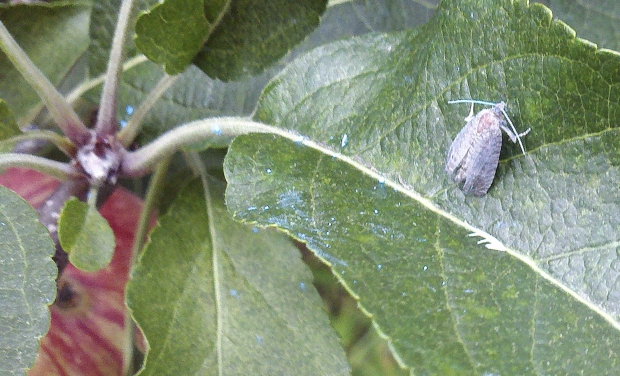
Sterile male moths can be identified in traps by their pink color when squashed (from the dye in their diet) and/or by being dusted with color, as these were. Trap captures indicate mating disruption failures—since the male moth was able to find the trap emitting the odor of female pheromone. (Courtesy Peter McGhee)
How much mating disruption pheromone does it take to adequately confuse male codling moths and prevent them from mating with females?

(Aurora E. Lee/Good Fruit Grower illustration)
That’s a $64,000 question, and one that scientist Peter McGhee is trying to answer.
So far, in his research, he’s found growers may be using a lot more material than they need to—perhaps eight times as much, or more. Reducing the amount used could translate into a major cost savings for growers and solidify the role of mating disruption in controlling codling moths and maybe other moths as well.
McGhee, who has been a research technician for entomologist Dr. Larry Gut at Michigan State University for 16 years, is close to finishing work on his doctorate. He and Gut were mentored in postgraduate programs by Dr. Jay Brunner at Washington State University some years ago, and all three have a special passion for mating disruption.
In recent years, they have studied whether aerosol emitters, which actively puff pheromone into the air, work as well as conventional pheromone dispensers such as Isomate CM ropes (twist ties), which emit pheromone passively by diffusion from the plastic.
They have specifically looked at how many aerosol units are needed and how often these need to dispense pheromone. The aerosol emitters are much less labor intensive to place in the orchard, but that labor savings has been offset by higher materials costs and some uncertainty about their performance.
For his doctoral work, McGhee decided to take a closer look.
“One of the problems in evaluating mating disruption is the low number of moths in the orchard,” McGhee said. It’s a good thing for growers, but bad for researchers.
Then an interesting solution presented itself. If he released sterile male codling moths into the research orchards, he would know precisely how many were released and, by trapping, learn the effectiveness of mating disruption dispensers.
If he found few moths in the traps, he’d know the dispensers were emitting enough pheromone to prevent moths from finding point sources such as female moths or traps.
Fortunately, there is a source of sterile male codling moths.
Apple growers in British Columbia, Canada, had geared up more than 20 years ago for a codling moth eradication program based on release of sterile male moths (Sterile Insect Release, or SIR).
While the Okanagan-Kootenay Sterile Insect Release Program suppressed codling moths pretty well, it didn’t achieve eradication, so growers had to supplement SIR with pheromone mating disruption and insecticide sprays in some hot spots.
The program dwindled. The Canadian government had built a sterile moth production facility in 1993, at a cost of $7.4 million. Where once it produced 12 million sterile moths a month, the production facility now had excess capacity. So it began selling sterile males for programs elsewhere—including for McGhee’s research.
By releasing sterile male codling moths in research orchards, there is no threat of insect damage from them, but it is a great way to test pheromone dispensers.
“We can get six or seven years’ worth of research data in one or two seasons using the sterile males,” McGhee said.
A dye incorporated into their diet while they’re growing up makes the sterile moths pink inside. When caught in traps and squashed, it’s clear whether they’re released moths or wild moths.
McGhee can also color the moths externally with a fluorescent powder that could be changed every week, providing data about the life span and sexual longevity of the moths.
The standard program for the aerosol emitters on the market calls for pheromone release for 12 hours starting at dusk. Is that good?
One-eighth
McGhee cut the amount of time in half, and then in half again. He found that six hours worked as well as twelve, and three was almost as good as six.
The standard program is to release pheromone four times every hour. He found that could be reduced to twice or even once per hour.
Tiny amounts are dispensed in puffs of aerosol. McGhee found that only half as much pheromone needed to be dispensed in each puff.
So, if the release period can be cut in half, and the number of releases per hour can be cut in half, and the amount of pheromone dispensed cut in half, the total pheromone used is one-eighth the standard amount.
McGhee found that the aerosol dispensers, which were tested against the rope, or twist tie, dispensers, were equally effective—something he and Gut had tried for several years to demonstrate.
He also found that two aerosol dispensers per acre was adequate, giving 94 to 96 percent suppression of codling moth. “One dispenser gets you pretty close, 88 to 90 percent,” he said.
The standard amount of pheromone loading is 70 grams in a canister, and it lasts season long but only one season. If the amount in each canister could be reduced to nine or ten grams, that would be a huge savings in the cost of pheromone needed to fill a canister.
McGhee and Gut believe that growers can get by using only mating disruption when moth populations are low. And, given good insecticides, they can get by with very few selected insecticide applications when populations are higher.
Mating disruption, monitoring with traps, and timely use of selective insecticides provide a stable three-legged stool that should lower the cost of codling moth control and remain a viable approach into a distant future. •






Leave A Comment